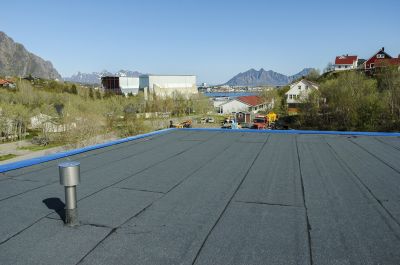Top-Rated Products for Flat Roof Replacement Projects
Compare leading materials and tools that can help you achieve a durable and effective flat roof upgrade.
 Replacing a flat roof involves selecting the right materials to ensure durability, weather resistance, and longevity. Flat roofs are common in commercial buildings and modern residential designs, requiring specific products tailored to their unique structure. When considering replacement options, it is essential to evaluate factors such as material lifespan, ease of installation, and compatibility with existing roofing systems. Properly chosen products can help prevent leaks, reduce maintenance needs, and improve overall building performance.
Replacing a flat roof involves selecting the right materials to ensure durability, weather resistance, and longevity. Flat roofs are common in commercial buildings and modern residential designs, requiring specific products tailored to their unique structure. When considering replacement options, it is essential to evaluate factors such as material lifespan, ease of installation, and compatibility with existing roofing systems. Properly chosen products can help prevent leaks, reduce maintenance needs, and improve overall building performance.
Top Overall Option
Modified Bitumen Roofing Membranes
Modified bitumen roofing membranes are a versatile and widely used option for flat roof replacements. They combine the durability of asphalt with added flexibility, making them suitable for various roof conditions. These membranes are typically installed with heat welding or adhesive methods, providing a robust barrier against water intrusion. Their resistance to UV rays and weathering can contribute to extended service life, making them a practical choice for many flat roofing applications.
Types of Products For Flat Roof Replacements
Built-Up Roofing (BUR) Systems
Multiple layers of bitumen and reinforcing fabrics create a durable, multi-ply roofing system that provides excellent waterproofing.
Single-Ply Membranes
Flexible sheets made from materials like TPO, PVC, or EPDM that are installed in one layer for ease of application and maintenance.
Modified Bitumen Membranes
As described above, these membranes offer a blend of asphalt's durability and added flexibility for flat roof needs.
Built-In Insulation Roofing
Systems that incorporate insulation layers within the roofing membrane to improve energy efficiency and thermal performance.
Green Roof Systems
Vegetative roofing options that include waterproof membranes underneath for eco-friendly and aesthetic benefits.
Liquid Roofing Coatings
Elastomeric or acrylic coatings that can be applied directly over existing surfaces to seal and protect the roof.
Spray-On Roof Coatings
Fast-curing coatings that provide seamless waterproofing, often used for repairs or small-scale replacements.
Self-Adhering Roofing Sheets
Pre-adhesived membranes that simplify installation and reduce the need for heat welding or torching.
Polyurethane Foam Roofing
Sprayed foam that creates a seamless, insulating, and waterproof layer over flat roofs.
EPDM Rubber Roofing
A synthetic rubber membrane known for its flexibility and resistance to weathering, suitable for various climates.
TPO Roofing Membranes
Thermoplastic polyolefin membranes that offer heat-welded seams and reflectivity for energy efficiency.
PVC Roofing Membranes
Polyvinyl chloride membranes that provide durability, chemical resistance, and ease of installation.
Popular Choices
Widely used for flat roofs due to their flexibility and weather resistance, suitable for various climates.
Known for their reflective properties and ease of installation, TPO membranes are a common choice for flat roofs.
Valued for chemical resistance and durability, PVC membranes are popular in commercial roofing applications.
Multiple layers of bitumen and reinforcing fabrics provide a traditional, reliable waterproofing solution.
Elastomeric coatings that can be applied directly over existing surfaces for quick repairs and waterproofing.
Seamless and flexible, these coatings are favored for small repairs and maintenance.
Ease of installation makes these membranes a trending choice for DIY or quick upgrades.
Providing insulation and waterproofing in one, these foam systems are increasingly popular for flat roof upgrades.
Offering a balance of durability and flexibility, these sheets are commonly used in commercial settings.
Growing in popularity for their aesthetic appeal and potential for additional insulation.
Pre-fabricated panels that combine insulation and waterproofing for streamlined installation.
Applied to improve energy efficiency by reflecting sunlight and reducing heat absorption.
Affordable and straightforward, suitable for small or less complex flat roof projects.
The selection process often begins with understanding the different types of roofing materials available. Each material offers distinct advantages and considerations, depending on the climate, building use, and budget. Some products are designed for quick installation, while others emphasize long-term performance. It is also crucial to consider the local weather conditions, as certain materials perform better in heavy rain, snow, or intense sunlight.
Professional consultation can aid in determining the most suitable products for a specific flat roof. Proper installation techniques are vital to maximize the lifespan of the replacement. Additionally, regular maintenance and inspections can help identify early signs of wear or damage, extending the effectiveness of the chosen materials. Ultimately, selecting the appropriate products for flat roof replacement can contribute significantly to the safety, functionality, and aesthetic appeal of the building.
Investing in quality materials and understanding the key features of each product type can lead to more satisfactory outcomes. Whether for a commercial property or a residential flat roof, informed choices help ensure the roof remains reliable and effective for years to come.
Key Buying Considerations
- Compatibility with existing roofing materials and structure.
- Weather resistance and suitability for local climate conditions.
- Ease and speed of installation procedures.
- Expected lifespan and maintenance requirements of the product.
- Waterproofing effectiveness and seam strength.
- UV resistance to prevent degradation over time.
- Thermal insulation properties, if applicable.
- Flexibility and ability to accommodate structural movements.
- Cost and overall budget constraints.
- Availability of warranties or guarantees from suppliers.
- Ease of repair and future upgrade options.
- Environmental conditions such as wind uplift and debris impact.
- Compatibility with insulation and other roofing components.
- Installation safety considerations and required expertise.
This content contains affiliate links. We may earn a commission if you purchase through these links, which helps support our work and provides you with curated product information.
